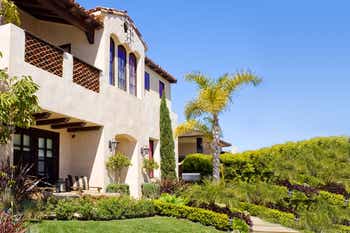Vegetation will either lead a fire to a structure, or stop it. The plants surrounding a house have one of the greatest influences on its chances of survival.
But nothing is easy in fire country, and that includes choosing the right plant. Picking plants for a fire protection is complicated because at some point every plant will burst into flames. Understanding the characteristics of a less flammable plant and the role of maintenance are essential to managing plants in fire country.
Every plant recommended for fire protection can catch on fire, but the ones below have a less likelihood than others. For more information about fire resistant plants, consult online Firewise plant guides, UC Extension education literature, and regional recommendations from wholesale and retail plant nurseries.
Seasonal change from damp to dry can have a big effect on landscapes and homes too. Dead and decaying plants are preventable, and just like rotted or cracked siding on your home, can be avoided with the proper maintenance strategy. While you routinely clean gutters and maintain your home with the change of seasons remember to also check on the health of plants in your landscape. You’ll enjoy your plants more if they’re kept trim and healthy, and they can help to protect your property during wildfire season as well.
Bonnie Lee
Vice President of Property Claims at Mercury Insurance
Plant Characteristics: The Good and Bad
Whether or not a plant will catch on fire, keep a fire going, or propel a fire is determined by its physical characteristics. Getting to know the characteristics of less flammable plants is fundamentally more important than remembering plant lists.
A Less Flammable Plant Will Have:
- Large and broad leaves rather than needle and blade-like leaves.
- Moist and easily bent leaves instead of stiff and leather-like leaves.
- Thick leaves instead of fine or thin leaves.
- A low amount of litter rather than a lot of duff.
- Sap that looks more like water opposed to thick, gummy or resinous sap.
- Leaves and stems without a fragrance, opposed to strong aromatic qualities.
- Leaves that are silver or gray.
- Leaves without hair (cilia).
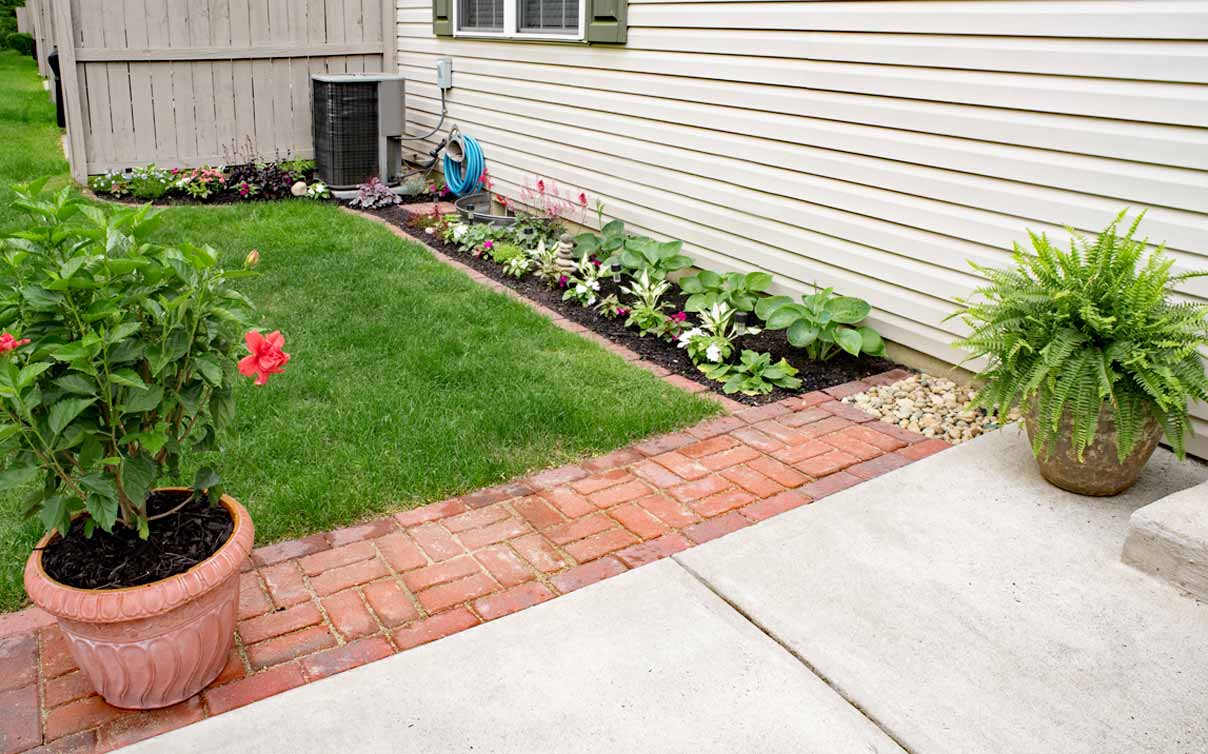
The Problems with Plant Lists
Every plant can ignite. The ability of any plant to retard or resist a fire depends on their condition. Any plant that is dying or dead, over-aged, water starved, infested by pests, or improperly cared for is more flammable as a consequence. Truly, landscape maintenance is the fulcrum of fire safety, not plant selection.
The Signs of a Plant that Needs Replacing
An old or unhealthy plant creates a greater degree of fire risk. These plants are more prone to breakage and deadwood, they require more resources and pesticides to sustain, and they may help spread diseases and pests. The characteristics of a plant that needs replacing include:
- Older leaves, stems and limbs are dead. On trees, 50% or more of the trunk has either dead limbs or no limbs.
- The living foliage is at the very end of the branches, instead of throughout the entire branch.
- During summer the plant drops more leaves than usual.
- The amount of living wood is less than 50% of the entire plant.
- A bud or disease infestation is difficult to control, if possible at all.
- A plant does not, or is slow to recover from injury.
- A plant that is showing signs of decay, which would include mushrooms coming up from its base and roots, or shelf fungi along its trunk.
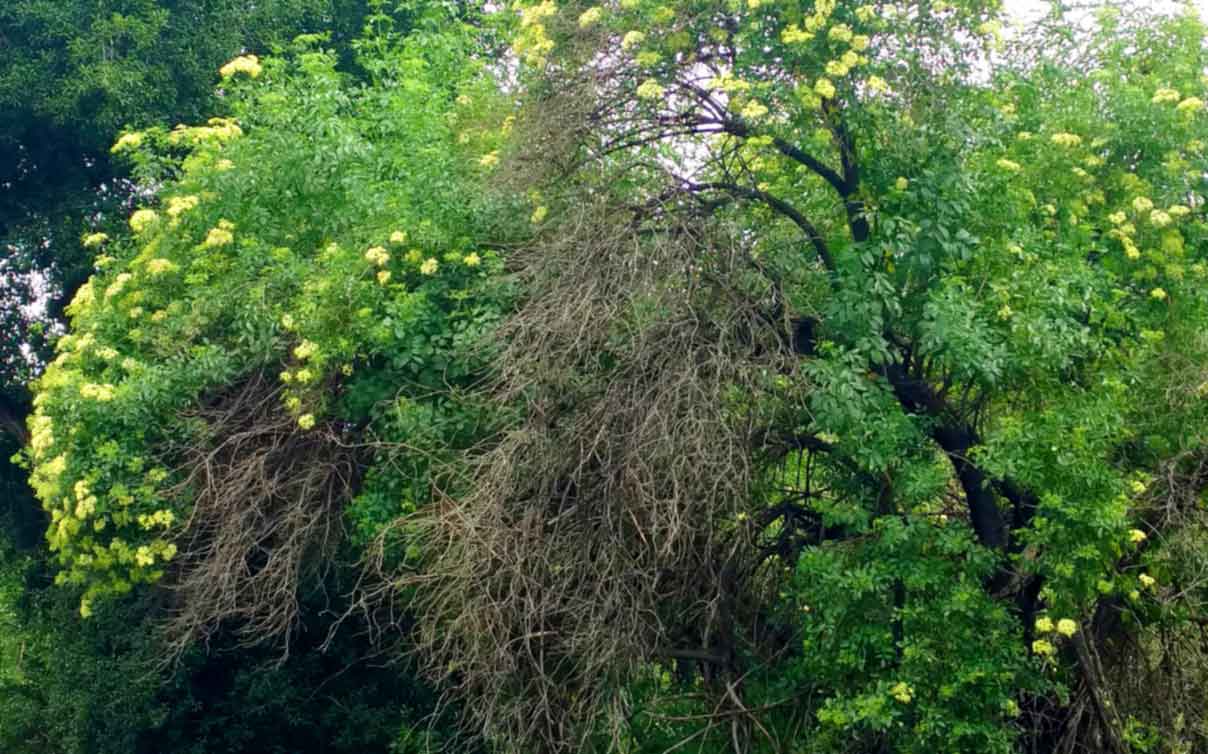
The elderberry in this picture is considered fire resistant. But the plant in this picture is anything but—it has a high likelihood of igniting if struck by a firebrand. A twiggy, dense and dead interior makes this plant vulnerable.
EVERYTHING HAS A LIFE
As a landscape nears, or passes its expected life span, the risk of fire dramatically rises. Use the generalized table below to budget and plan for the removal of mature plants. As illustrated, a landscape that was planted 50 years ago may require the removal of some, if not most of the plants.
|
Plant Group |
Expected Life |
|---|---|
|
Large Trees |
40–120 years |
|
Medium Trees |
18–60 years |
|
Large Shrubs |
8–25 years |
|
Small Shrubs |
5–15 years |
|
Vines |
6–15 (except asexual vines, like ivy, which root from shoots and roots) |
|
Perennials |
2–6 years |
|
Biennial |
2 years |
|
Annuals |
Every Year |
Plant Lists
Two types of plants are recommended for a firescaped garden: fire retardant and fire resistant plants. The definition of each follows and further below are fire retardant/resistant plants for lawn alternatives, hedges and screens, and erosion control.
Fire Retardant
The plants used in Zone 1 are considered fire retardant. These plants are fleshy and moist and will sizzle and wilt when exposed to flames and heat, but are reluctant to produce a flame. If properly maintained, these plants can catch and extinguish firebrands. The tradeoff for this protection is maintenance and irrigation.
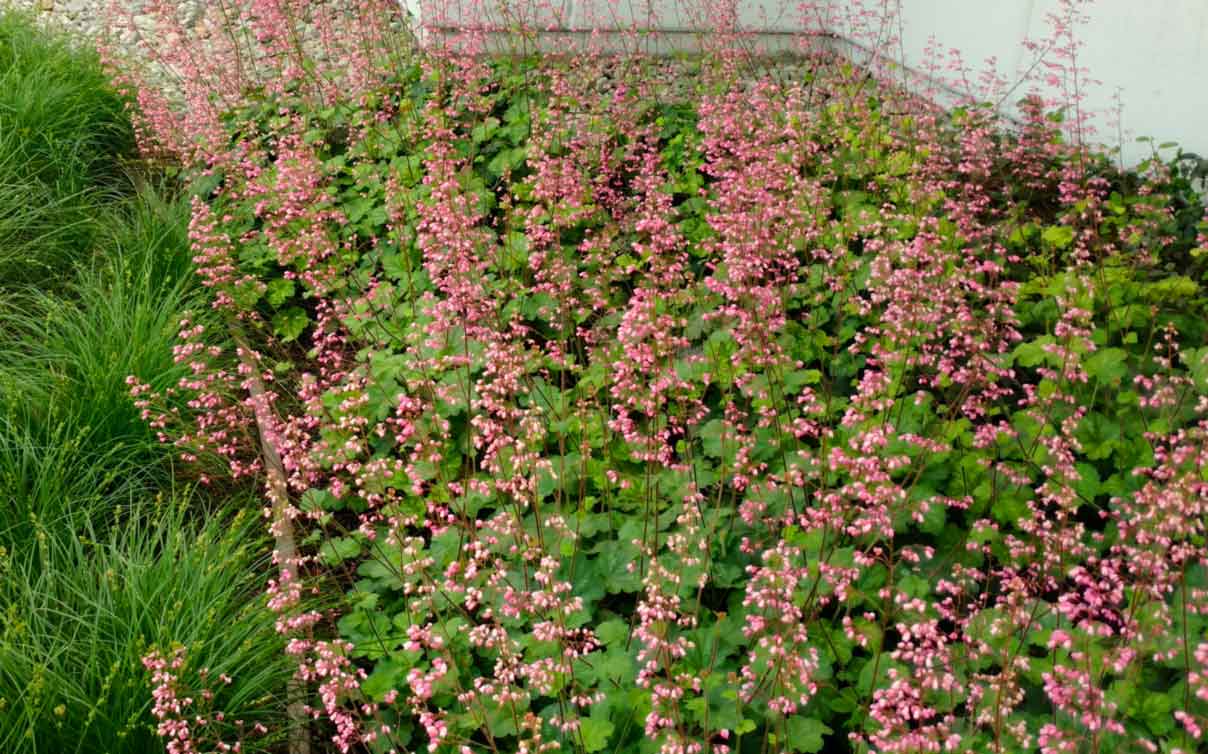
Coral bells (Heuchera spp.) will thrive on the cooler sides of a structure and if well maintained, can endure intense heat and firebrands without igniting.
Fire Resistant
A fire resistant plant repels fire. Their leaves and twiggy growth will produce a flame when exposed to flames and heat, but the flame quickly dies. Thick bark and dense wood protects the plant from fully igniting. Many of these plants survive direct flame contact and will resprout within a month after a wildfire. Using plants that resist fire and rapidly resprout is vital to reducing risks of erosion following a fire. Although fire resistant plants are drought adapted, most would benefit with an occasional deep watering.
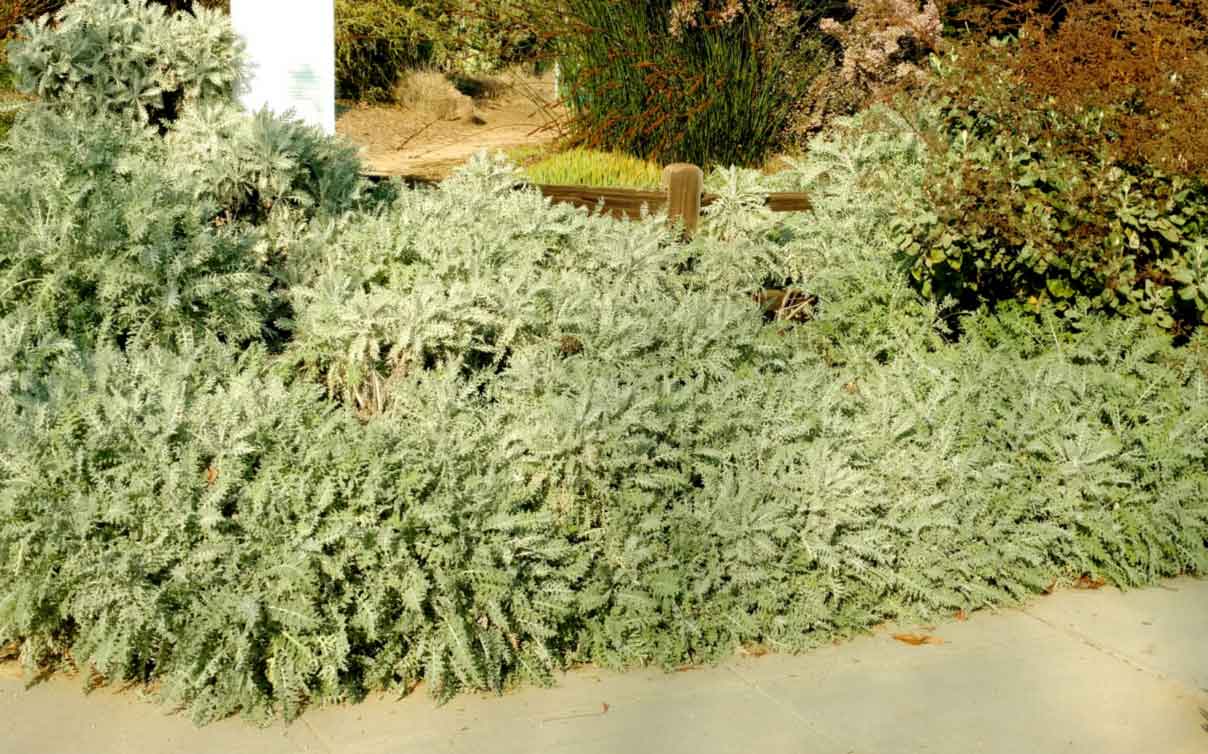
Silver spreader (Artemisia caucasica) can be fire resistant. It is also good at suppressing weeds and recovering from damage.
Lawn Alternatives
A lawn alternative has certain characteristics: they are low growing, water conserving, and heal from damage, such as trampling. The plants listed below can also help repel a wildfire by enduring firebrands and heat. They are perennial, fleshy, and spread vegetatively.
|
Common Name |
Botanical Name |
|---|---|
|
Yarrow |
Achillea spp. |
|
Ajuga, carpet bugle |
Ajuga spp. |
|
Rockcress |
Arabis spp. |
|
Wild aster |
Aster spp |
|
Bellflower |
Campanula spp. |
|
Dwarf plumbago |
Ceratostigma plumbaginoides |
|
Chamomile |
Chamaemelum nobile |
|
Tickseed |
Coreopsis auriculata ‘Nana’ |
|
Indian mock strawberry |
Duchesnea indica |
|
Fleabane |
Erigeron spp. |
|
Creeping red fescue |
Festuca rubra |
|
Wild strawberry, sand strawberry |
Fragaria spp. |
|
Gazania |
Gazania spp. |
|
Cranesbill |
Geranium spp. |
|
English, Hahn’s and smaller leafed ivies |
Hedera helix, H. ‘Hahn’s’, H. ‘Needlepoint’ |
|
Rupture wort |
Herniaria glabra |
|
Dead nettle |
Lamium spp. |
|
Bird’s foot trefoil |
Lotus corniculatus |
|
Pachysandra |
Pachysandra spp. |
|
Creeping phlox, moss phlox |
Phlox subulata |
|
Lippia |
Phyla nodiflora |
|
Cinquefoil |
Potentilla spp. |
|
Irish and Scotch moss |
Sagina subulata |
|
Hedgenettle, betony |
Stachys spp. |
|
Strawberry and white clover |
Trifolium spp. |
|
Periwinkle |
Vinca spp. |
|
Viola |
Viola odorata |
|
Zoysia |
Zoysia spp. |
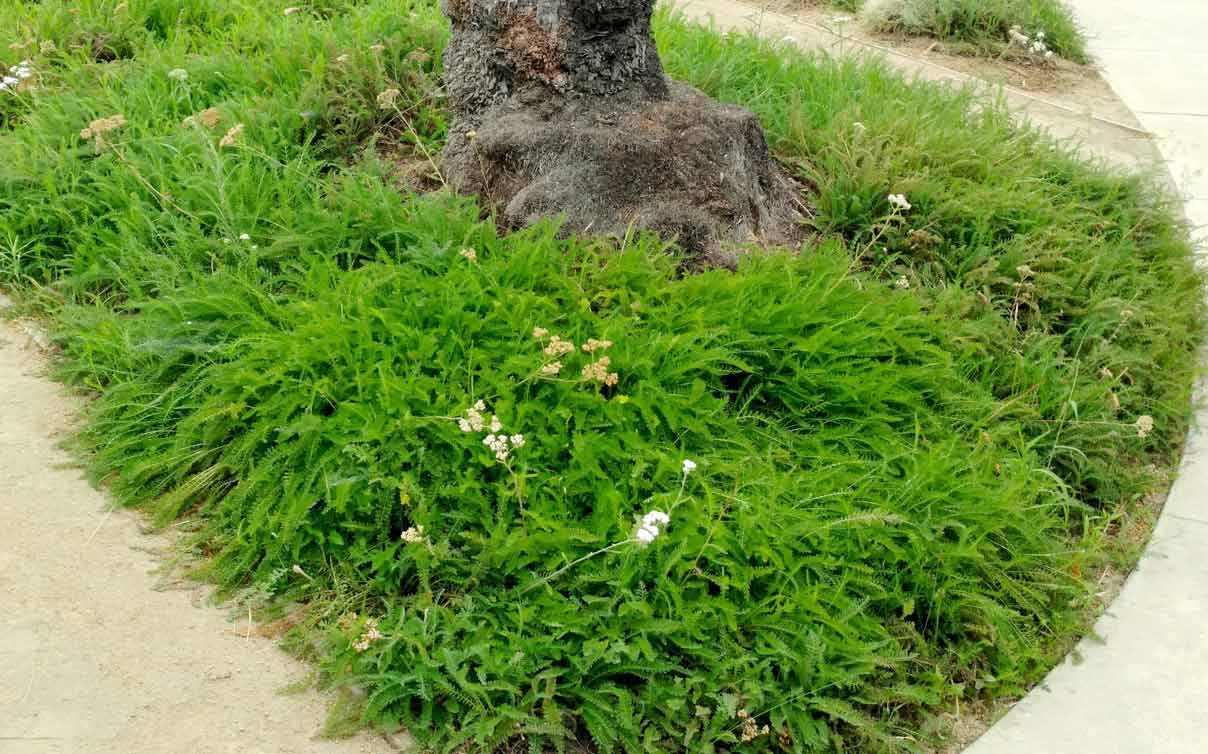
The California native strawberry makes a great ground cover. It is self-healing, competitive and colorful at times.
Hedges and Screening Plants
The pursuit of privacy greatly increases fuel in fire country. Hedge and screening plants are typically large, dense and planted close together, creating freeways for fire if not managed properly. The plants below have a less likelihood of igniting and have large, supple and mostly non-aromatic leaves.
Maintenance is essential for screening plants in fire country. Here are some tips:
- Clean its interior of fine and dead material.
- Every other year remove one-fifth of the larger branches to promote new growth from within the plant.
- Remove leaves, debris and flammable weeds from around hedges and fences.
- Deeply water in summer/fall to ensure proper leaf moisture.
- Dense screening plants will need replacement in 8 to 14 years.
|
Common Name |
Botanical Name |
|---|---|
|
Japanese Aucuba |
Aucuba japonica |
|
Carolina allspice, spice bush |
Calycanthus spp. |
|
Camellia |
Camellia spp. |
|
Flowering quince |
Chaenomeles spp |
|
Elaeagnus, oleaster |
Elaeagnus ebbingei |
|
Evergreen Euonymus |
Euonymus japonicus |
|
Japanese Aralia |
Fatsia japonica |
|
Privet |
Ligustrum spp. |
|
Oleander |
Nerium oleander |
|
Osmanthus, sweet olive, fragrant olive |
Osmanthus spp. |
|
Mock orange, mockorange |
Philadelphus spp. |
|
Photinia |
Photinia x fraseri |
|
Japanese mock orange, Tobira |
Pittosporum tobira |
|
Laurel |
Prunus laurocerasus, P. lusitanica |
|
Buckthorn, coffeeberry, redberry |
Rhamnus spp. |
|
Sumac |
Rhus spp. |
|
Currant, Gooseberry |
Ribes spp. |
|
Jojoba |
Simmondsia chinensis |
|
Viburnum |
Viburnum spp. |
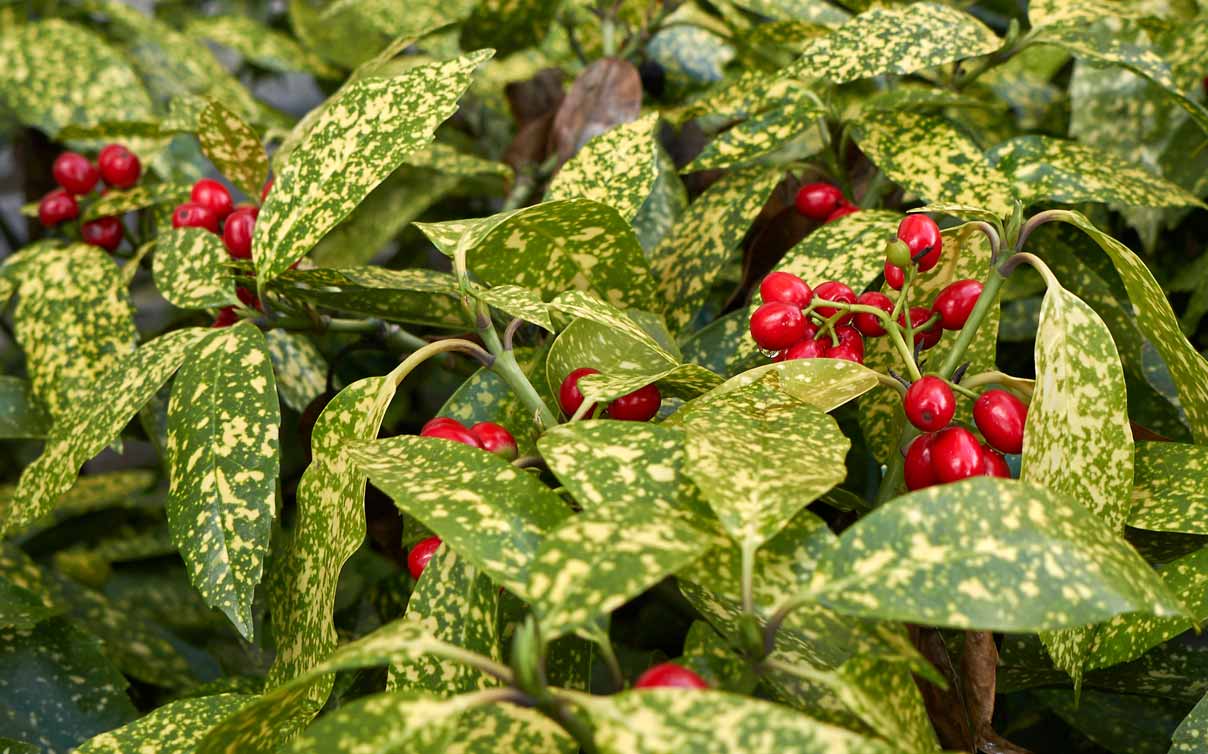
Japanese Aucuba
Fire Resistant Shrubs for Erosion Control
Ground hugging and drought adapted, supple leaves and low amounts of litter are what define a hill holding plant in fire country.
|
Common Name |
Botanical Name |
|---|---|
|
Manzanita, vine hill |
Arctostaphylos densiflora |
|
Manzanita, little Sur |
Arctostaphylos edmundsii |
|
Manzanita, emerald green |
Arctostaphylos ‘Emerald Green’ |
|
Bearberry |
Arctostaphylos uva-ursi |
|
Cape weed |
Arctotheca calendula |
|
Silver spreader |
Artemisia caucasica |
|
Angel’s hair |
Artemisia schmidtiana |
|
Coyote brush, dwarf |
Baccharis pilularis ‘Twin Peaks’ |
|
Natal plum |
Carissa prostrates ‘Green Carpet’ |
|
Ceanothus, Point Reyes |
Ceanothus gloriosus |
|
Ceanothus, Carmel creeper |
Ceanothus griseus horizontalis |
|
Ceanothus, Squaw carpet |
Ceanothus prostrates, C. p. occidentalis |
|
Rockrose, sageleaf |
Cistus salviifolius |
|
Coprosma |
Coprosma x kirkii, C. pumila |
|
Cotoneaster, creeping |
Cotoneaster adpressus |
|
Cotoneaster, barberry |
Cotoneaster dammeri |
|
Cotoneaster, rock |
Cotoneaster horizontalis |
|
Cotoneaster, rockspray |
Cotoneaster microphyllus |
|
Mirror plant, prostrate |
Euonymus fortunei |
|
Lantana, trailing |
Lantana montevidensis |
|
Myoporum, prostrate |
Myoporum parvifolium |
|
Australian bluebell creeper |
Sollya parviflora |
|
Germander, prostrate |
Teucrium chamaedrys, T. cossonii majoricum |
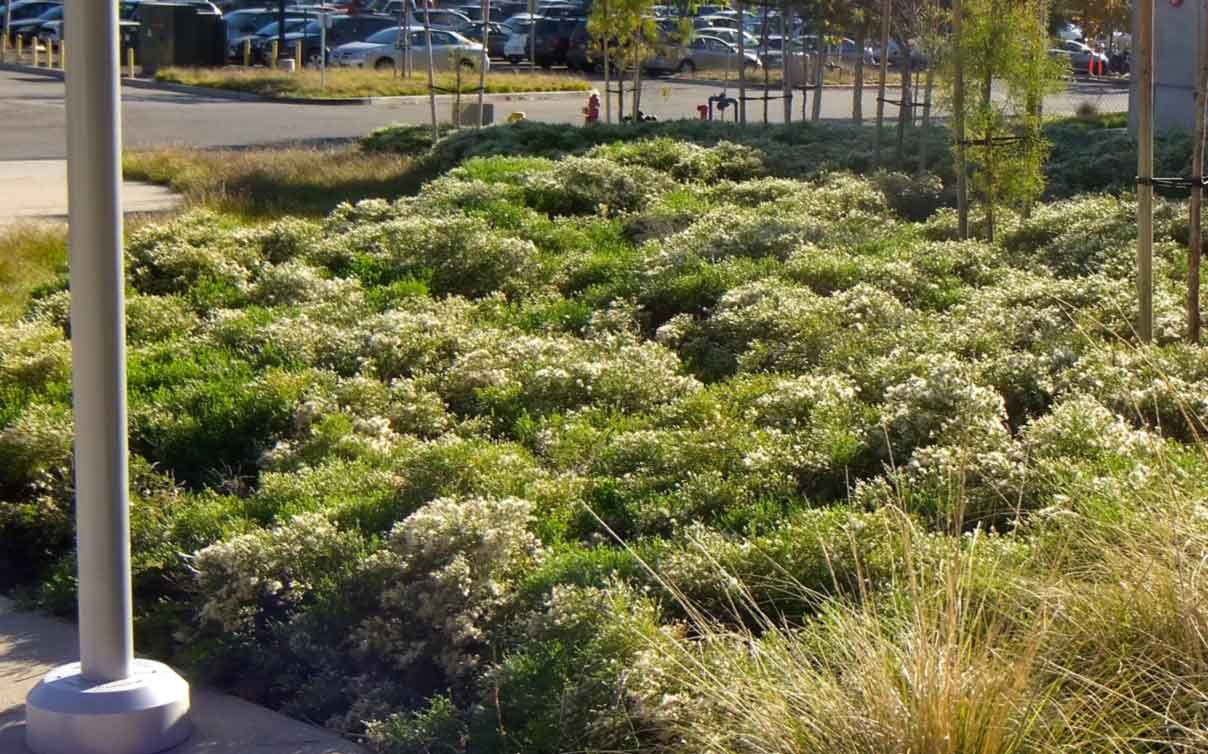
Coyote brush, dwarf

